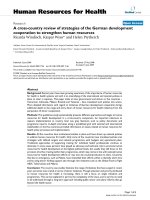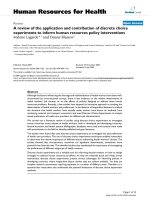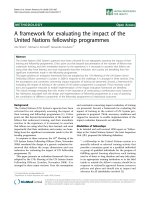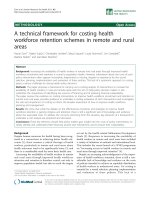Báo cáo sinh học: "A modified Mann iterative scheme by generalized f-projection for a countable family of relatively quasi-nonexpansive mappings and a system of generalized mixed equilibrium problems" pptx
Bạn đang xem bản rút gọn của tài liệu. Xem và tải ngay bản đầy đủ của tài liệu tại đây (296 KB, 33 trang )
Fixed Point Theory and
Applications
This Provisional PDF corresponds to the article as it appeared upon acceptance. Fully formatted
PDF and full text (HTML) versions will be made available soon.
A modified Mann iterative scheme by generalized f-projection for a countable
family of relatively quasi-nonexpansive mappings and a system of generalized
mixed equilibrium problems
Fixed Point Theory and Applications 2011, 2011:104
doi:10.1186/1687-1812-2011-104
Siwaporn Saewan ()
Poom Kumam ()
ISSN
Article type
1687-1812
Research
Submission date
23 July 2011
Acceptance date
21 December 2011
Publication date
21 December 2011
Article URL
/>
This peer-reviewed article was published immediately upon acceptance. It can be downloaded,
printed and distributed freely for any purposes (see copyright notice below).
For information about publishing your research in Fixed Point Theory and Applications go to
/>For information about other SpringerOpen publications go to
© 2011 Saewan and Kumam ; licensee Springer.
This is an open access article distributed under the terms of the Creative Commons Attribution License ( />which permits unrestricted use, distribution, and reproduction in any medium, provided the original work is properly cited.
A modified Mann iterative scheme by
generalized f -projection for a
countable family of relatively
quasi-nonexpansive mappings and a
system of generalized mixed
equilibrium problems
Siwaporn Saewan∗1 and Poom Kumam∗1,2
1
Department of Mathematics, Faculty of Science
King Mongkut’s University of Technology Thonburi (KMUTT)
Bangmod, Bangkok 10140, Thailand
2
Centre of Excellence in Mathematics, CHE
Si Ayutthaya Rd., Bangkok 10400, Thailand
∗
Corresponding authors: si wa
Email address:
PK: ;
Abstract
The purpose of this paper is to introduce a new hybrid projection
method based on modified Mann iterative scheme by the generalized f -projection operator for a countable family of relatively quasinonexpansive mappings and the solutions of the system of generalized
mixed equilibrium problems. Furthermore, we prove the strong convergence theorem for a countable family of relatively quasi-nonexpansive
mappings in a uniformly convex and uniform smooth Banach space.
Finally, we also apply our results to the problem of finding zeros of
B-monotone mappings and maximal monotone operators. The results
1
presented in this paper generalize and improve some well-known results in the literature.
Keywords: The generalized f -projection operator; relatively quasinonexpansive mapping; B-monotone mappings; maximal monotone
operator; system of generalized mixed equilibrium problems.
2000 Mathematics Subject Classification: 47H05; 47H09; 47H10.
1
Introduction
The theory of equilibrium problems, the development of an efficient and implementable iterative algorithm, is interesting and important. This theory
combines theoretical and algorithmic advances with novel domain of applications. Analysis of these problems requires a blend of techniques from convex
analysis, functional analysis, and numerical analysis.
Equilibrium problems theory provides us with a natural, novel, and unified framework for studying a wide class of problems arising in economics,
finance, transportation, network, and structural analysis, image reconstruction, ecology, elasticity and optimization, and it has been extended and generalized in many directions. The ideas and techniques of this theory are being
used in a variety of diverse areas and proved to be productive and innovative.
In particular, generalized mixed equilibrium problem and equilibrium problems are related to the problem of finding fixed points of nonlinear mappings.
Let E be a real Banach space with norm · , C be a nonempty closed
convex subset of E and let E ∗ denote the dual of E. Let {θi }i∈Λ : C ×C → R
be a bifunction, {ϕi }i∈Λ : C → R be a real-valued function, and {Ai }i∈Λ :
C → E ∗ be a monotone mapping, where Λ is an arbitrary index set. The
system of generalized mixed equilibrium problems is to find x ∈ C such that
θi (x, y) + Ai x, y − x + ϕi (y) − ϕi (x) ≥ 0,
i ∈ Λ, ∀y ∈ C.
(1.1)
If Λ is a singleton, then problem (1.1) reduces to the generalized mixed equilibrium problem is to find x ∈ C such that
θ(x, y) + Ax, y − x + ϕ(y) − ϕ(x) ≥ 0,
∀y ∈ C.
(1.2)
The set of solutions to (1.2) is denoted by GMEP(θ, A, ϕ), i.e.,
GMEP(θ, A, ϕ) = {x ∈ C : θ(x, y)+ Ax, y−x +ϕ(y)−ϕ(x) ≥ 0,
2
∀y ∈ C}.
(1.3)
If A ≡ 0, the problem (1.2) reduces to the mixed equilibrium problem for θ,
denoted by MEP(θ, ϕ) is to find x ∈ C such that
θ(x, y) + ϕ(y) − ϕ(x) ≥ 0,
∀y ∈ C.
(1.4)
If θ ≡ 0, the problem (1.2) reduces to the mixed variational inequality of
Browder type, denoted by V I(C, A, ϕ) is to find x ∈ C such that
Ax, y − x + ϕ(y) − ϕ(x) ≥ 0,
∀y ∈ C.
(1.5)
If A ≡ 0 and ϕ ≡ 0 the problem (1.2) reduces to the equilibrium problem for
θ, denoted by EP(θ) is to find x ∈ C such that
θ(x, y) ≥ 0,
∀y ∈ C.
(1.6)
If θ ≡ 0, the problem (1.4) reduces to the minimize problem, denoted by
Argmin(ϕ) is to find x ∈ C such that
ϕ(y) − ϕ(x) ≥ 0,
∀y ∈ C.
(1.7)
The generalized mixed equilibrium problems include fixed point problems,
optimization problems, variational inequality problems, Nash equilibrium
problems, and the equilibrium problems as special cases. Moreover, the above
formulation (1.5) was shown in [1] to cover monotone inclusion problems, saddle point problems, variational inequality problems, minimization problems,
optimization problems, vector equilibrium problems, and Nash equilibria in
noncooperative games. In other words, the GMEP(θ, A, ϕ), MEP(θ, ϕ) and
EP(θ) are an unifying model for several problems arising in physics, engineering, science, optimization, economics, etc. Many authors studied and
constructed some solution methods to solve the GMEP(θ, A, ϕ), MEP(θ, ϕ),
EP(θ) [1–16, and references therein].
Let C be a closed convex subset of E and recall that a mapping T : C → C
is said to be nonexpansive if
Tx − Ty ≤ x − y ,
∀x, y ∈ C.
A point x ∈ C is a fixed point of T provided T x = x. Denote by F (T ) the
set of fixed points of T , that is, F (T ) = {x ∈ C : T x = x}.
As we know that if C is a nonempty closed convex subset of a Hilbert
space H and recall that the (nearest point) projection PC from H onto C
3
assigns to each x ∈ H, the unique point in PC x ∈ C satisfying the property
x − PC x = miny∈C x − y , then we also have PC is nonexpansive. This
fact actually characterizes Hilbert spaces and consequently, it is not available
in more general Banach spaces. We consider the functional defined by
φ(y, x) = y
2
− 2 y, Jx + x 2 ,
for x, y ∈ E,
(1.8)
where J is the normalized duality mapping. In this connection, Alber [17]
introduced a generalized projection ΠC from E in to C as follows:
ΠC (x) = arg min φ(y, x),
y∈C
∀x ∈ E.
(1.9)
It is obvious from the definition of functional φ that
( y − x )2 ≤ φ(y, x) ≤ ( y + x )2 ,
∀x, y ∈ E.
(1.10)
If E is a Hilbert space, then φ(y, x) = y − x 2 and ΠC becomes the metric
projection of E onto C. The generalized projection ΠC : E → C is a map
that assigns to an arbitrary point x ∈ E the minimum point of the functional
φ(y, x), that is, ΠC x = x, where x is the solution to the minimization problem
¯
¯
φ(¯, x) = inf φ(y, x).
x
y∈C
(1.11)
The existence and uniqueness of the operator ΠC follow from the properties
of the functional φ(y, x) and strict monotonicity of the mapping J [17–21]. It
is well known that the metric projection operator plays an important role in
nonlinear functional analysis, optimization theory, fixed point theory, nonlinear programming, game theory, variational inequality, and complementarity
problems, etc. [17, 22]. In 1994, Alber [23] introduced and studied the generalized projections from Hilbert spaces to uniformly convex and uniformly
smooth Banach spaces. Moreover, Alber [17] presented some applications
of the generalized projections to approximately solve variational inequalities
and von Neumann intersection problem in Banach spaces. In 2005, Li [22]
extended the generalized projection operator from uniformly convex and uniformly smooth Banach spaces to reflexive Banach spaces and studied some
properties of the generalized projection operator with applications to solve
the variational inequality in Banach spaces. Later, Wu and Huang [24] introduced a new generalized f -projection operator in Banach spaces. They
extended the definition of the generalized projection operators introduced by
4
Abler [23] and proved some properties of the generalized f -projection operator. In 2009, Fan et al. [25] presented some basic results for the generalized
f -projection operator and discussed the existence of solutions and approximation of the solutions for generalized variational inequalities in noncompact
subsets of Banach spaces.
Let ·, · denote the duality pairing of E ∗ and E. Next, we recall the
concept of the generalized f -projection operator. Let G : C × E ∗ −→ R ∪
{+∞} be a functional defined as follows:
G(ξ,
)= ξ
2
− 2 ξ,
+
2
+ 2ρf (ξ),
(1.12)
where ξ ∈ C, ∈ E ∗ , ρ is positive number and f : C → R ∪ {+∞} is proper,
convex, and lower semicontinuous. By the definitions of G, it is easy to see
the following properties:
(1) G(ξ,
) is convex and continuous with respect to
when ξ is fixed;
(2) G(ξ, ) is convex and lower semicontinuous with respect to ξ when
is fixed.
Definition 1.1. Let E be a real Banach space with its dual E ∗ . Let C
f
be a nonempty closed convex subset of E. We say that πC : E ∗ → 2C is
generalized f -projection operator if
f
πC
= {u ∈ C : G(u,
) = inf G(ξ,
ξ∈C
)},
∀
∈ E ∗.
Observe that, if f (x) = 0, then the generalized f -projection operator
(1.12) reduces to the generalized projection operator (1.9).
For the generalized f -projection operator, Wu and Hung [24] proved the
following basic properties:
Lemma 1.2. [24] Let E be a real reflexive Banach space with its dual E ∗
and C a nonempty closed convex subset of E. Then the following statement
holds:
f
(1) πC
is a nonempty closed convex subset of C for all
(2) if E is smooth, then for all
x − y,
f
∈ E ∗ , x ∈ πC
∈ E ∗;
if and only if
− Jx + ρf (y) − ρf (x) ≥ 0, ∀y ∈ C;
5
(3) if E is strictly convex and f : C → R ∪ {+∞} is positive homogeneous
(i.e., f (tx) = tf (x) for all t > 0 such that tx ∈ C where x ∈ C), then
f
πC is single-valued mapping.
Recently, Fan et al. [25] show that the condition f is positive homogeneous
which appeared in [25, Lemma 2.1 (iii)] can be removed.
Lemma 1.3. [25] Let E be a real reflexive Banach space with its dual E ∗
and C a nonempty closed convex subset of E. If E is strictly convex, then
f
πC is single valued.
Recall that J is single value mapping when E is a smooth Banach space.
There exists a unique element ∈ E ∗ such that = Jx where x ∈ E. This
substitution for (1.12) gives
G(ξ, Jx) = ξ
2
− 2 ξ, Jx + x
2
+ 2ρf (ξ).
(1.13)
Now we consider the second generalized f projection operator in Banach
space [26].
Definition 1.4. Let E be a real smooth and Banach space and C be a
nonempty closed convex subset of E. We say that Πf : E → 2C is generalized
C
f -projection operator if
Πf x = {u ∈ C : G(u, Jx) = inf G(ξ, Jx)}, ∀x ∈ E.
C
ξ∈C
Next, we give the following example [27] of metric projection, generalized
projection operator and generalized f -projection operator do not coincide.
Example 1.5. Let X = R3 be provided with the norm (x1 , x2 , x3 ) =
(x2 + x2 ) + x2 + x2 .
1
2
2
3
This is a smooth strictly convex Banach space and C = {x ∈ R3 |x2 = 0, x3 =
0} is a closed and convex subset of X. It is a simple computation; we get
PC (1, 1, 1) = (1, 0, 0),
ΠC (1, 1, 1) = (2, 0, 0)
We set ρ = 1 is positive number and define f : C → R ∪ {+∞} by
√
2+2 √
5,
x < 0;
f (x) =
−2 − 2 5, x ≥ 0.
Then, f is proper, convex, and lower semicontinuous. Simple computations
show that
Πf (1, 1, 1) = (4, 0, 0).
C
6
Recall that a point p in C is said to be an asymptotic fixed point of T
[28] if C contains a sequence {xn } which converges weakly to p such that
limn→∞ xn − T xn = 0. The set of asymptotic fixed points of T will be
denoted by F (T ). A mapping T from C into itself is said to be relatively
nonexpansive mapping [29–31] if
(R1) F (T ) is nonempty;
(R2) φ(p, T x) ≤ φ(p, x) for all x ∈ C and p ∈ F (T );
(R3) F (T ) = F (T ).
A mapping T is said to be relatively quasi-nonexpansive ( or quasi-φ-nonexpansive)
if the conditions (R1) and (R2) are satisfied. The asymptotic behavior of a
relatively nonexpansive mapping was studied in [32–34]. The class of relatively quasi-nonexpansive mappings is more general than the class of relatively nonexpansive mappings [11, 32–35] which requires the strong restriction: F (T ) = F (T ). In order to explain this better, we give the following
example [36] of relatively quasi-nonexpansive mappings which is not relatively nonexpansive mapping. It is clearly by the definition of relatively
quasi-nonexpansive mapping T is equivalent to F (T ) = ∅ and G(p, JT x) ≤
G(p, Jx) for all x ∈ C and p ∈ F (T ).
Example 1.6. Let E be any smooth Banach space and let x0 = 0 be any
element of E.
We define a mapping T : E → E by
T (x) =
(1 +
2
−x,
1
)x0 ,
2n
1
if x = ( 2 +
1
if x = ( 2 +
1
)x0 ;
2n
1
)x0 .
2n
Then T is a relatively quasi-nonexpansive mapping but not a relatively nonexpansive mapping. Actually, T above fails to have the condition (R3).
Next, we give some examples which are closed quasi-φ-nonexpansive [4, Examples 2.3 and 2.4].
Example 1.7. Let E be a uniformly smooth and strictly convex Banach space
and A ⊂ E × E ∗ be a maximal monotone mapping such that its zero set
A−1 0 = ∅. Then, Jr = (J + rA)−1 JJ is a closed quasi-φ-nonexpansive mapping from E onto D(A) and F (Jr ) = A−1 0.
7
Proof By Matsushita and Takahashi [35, Theorem 4.3], we see that Jr is relatively nonexpansive mapping from E onto D(A) and F (Jr ) = A−1 0. Therefore, Jr is quasi-φ-nonexpansive mapping from E onto D(A) and F (Jr ) =
A−1 0. On the other hand, we can obtain the closedness of Jr easily from the
continuity of the mapping J and the maximal monotonicity of A; see [35] for
more details.
Example 1.8. Let C be the generalized projection from a smooth, strictly
convex, and reflexive Banach space E onto a nonempty closed convex subset
C of E. Then, C is a closed quasi-φ-nonexpansive mapping from E onto C
with F (ΠC ) = C.
In 1953, Mann [37] introduced the iteration as follows: a sequence {xn }
defined by
xn+1 = αn xn + (1 − αn )T xn ,
(1.14)
where the initial guess element x1 ∈ C is arbitrary and {αn } is real sequence
in [0, 1]. Mann iteration has been extensively investigated for nonexpansive mappings. One of the fundamental convergence results is proved by
Reich [38]. In an infinite-dimensional Hilbert space, Mann iteration can conclude only weak convergence [39,40]. Attempts to modify the Mann iteration
method (1.14) so that strong convergence is guaranteed have recently been
made. Nakajo and Takahashi [41] proposed the following modification of
Mann iteration method as follows:
x1 = x ∈ C is arbitrary,
yn = αn Jxn + (1 − αn )T xn ,
Cn = {z ∈ C : yn − z ≤ xn − z },
(1.15)
Qn = {z ∈ C : xn − z, x − xn ≥ 0},
xn+1 = PCn ∩Qn x, n ≥ 1.
They proved that if the sequence {αn } bounded above from one, then {xn }
defined by (1.15) converges strongly to PF (T ) x.
In 2007, Aoyama et al. [42, Lemma 3.1] introduced {Tn } is a sequence
of nonexpansive mappings of C into itself with ∩∞ F (Tn ) = ∅ satisfy the
n=1
following condition: if for each bounded subset B of C, ∞ sup{ Tn+1 z −
n=1
Tn z : z ∈ B < ∞}. Assume that if the mapping T : C → C defined by
T x = limn→∞ Tn x for all x ∈ C, then limn→∞ sup{ T z − Tn z : z ∈ C} = 0.
They proved that the sequence {Tn } converges strongly to some point of C
for all x ∈ C.
8
In 2009, Takahashi et al. [43] studied and proved a strong convergence
theorem by the new hybrid method for a family of nonexpansive mappings
in Hilbert spaces as follows: x0 ∈ H, C1 = C and x1 = PC1 x0 and
yn = αn xn + (1 − αn )Tn xn ,
Cn+1 = {z ∈ C : yn − z ≤ xn − z },
(1.16)
xn+1 = PCn+1 x0 , n ≥ 1,
where 0 ≤ αn ≤ a < 1 for all n ∈ N and {Tn } is a sequence of nonexpansive
mappings of C into itself such that ∩∞ F (Tn ) = ∅. They proved that if
n=1
{Tn } satisfies some appropriate conditions, then {xn } converges strongly to
P∩∞ F (Tn ) x0 .
n=1
The ideas to generalize the process (1.14) from Hilbert spaces have recently been made. By using available properties on a uniformly convex and
uniformly smooth Banach space, Matsushita and Takahashi [35] proposed the
following hybrid iteration method with generalized projection for relatively
nonexpansive mapping T in a Banach space E:
x0 ∈ C chosen arbitrarily,
yn = J −1 (αn Jxn + (1 − αn )JT xn ),
Cn = {z ∈ C : φ(z, yn ) ≤ φ(z, xn )},
(1.17)
Qn = {z ∈ C : xn − z, Jx0 − Jxn ≥ 0},
xn+1 = ΠCn ∩Qn x0 .
They proved that {xn } converges strongly to ΠF (T ) x0 , where ΠF (T ) is the
generalized projection from C onto F (T ). Plubtieng and Ungchittrakool [44]
introduced and proved the processes for finding a common fixed point of
a countable family of relatively nonexpansive mappings in a Banach space.
They proved the strong convergence theorems for a common fixed point of
a countable family of relatively nonexpansive mappings {Tn } provided that
{Tn } satisfies the following condition:
• if for each bounded subset D of C, there exists a continuous increasing and convex function h : R+ → R+ . such that h(0) = 0 and
limk,l→∞ supz∈D h( Tk z − Tl z ) = 0.
Motivated by the results of Takahashi and Zembayashi [13], Cholumjiak
and Suantai [2] proved the following strong convergence theorem by the hybrid iterative scheme for approximation of common fixed point of countable
families of relatively quasi-nonexpansive mappings {Ti } on C into itself in a
9
uniformly convex and uniformly smooth Banach space: x0 ∈ E, x1 = ΠC1 x0 ,
C1 = C
yn,i = J −1 (αn Jxn + (1 − αn )JTi xn ),
un,i = TrFm TrFm−1 . . . TrF1 yn,i
m,n
m−1,n
1,n
(1.18)
Cn+1 = {z ∈ Cn : supi>1 φ(z, Jun,i ) ≤ φ(w, Jxn )},
xn+1 = ΠCn+1 x0 , n ≥ 1,
where TrFi , i = 1, 2, 3, . . . , m defined in Lemma 2.8. Then, they proved
i,n
that under certain appropriate conditions imposed on {αn }, and {rn,i }, the
sequence {xn } converges strongly to ΠCn+1 x0 .
Recently, Li et al. [26] introduced the following hybrid iterative scheme
for approximation of fixed point of relatively nonexpansive mapping using
the properties of generalized f -projection operator in a uniformly smooth
real Banach space which is also uniformly convex: x0 ∈ C,
−1
yn = J (αn Jxn + (1 − αn )JT xn ),
Cn+1 = {w ∈ Cn : G(w, Jyn ) ≤ G(w, Jxn )},
(1.19)
xn+1 = Πf n+1 x0 , n ≥ 1
C
They obtained a strong convergence theorem for finding an element in the
fixed point set of T . The results of Li et al. [26] extended and improved on
the results of Matsushita and Takahashi [35].
Very recently, Shehu [45] studied and obtained the following strong convergence theorem by the hybrid iterative scheme for approximation of common fixed point of finite family of relatively quasi-nonexpansive mappings
in a uniformly convex and uniformly smooth Banach space: let x0 ∈ C,
x1 = ΠC1 x0 , C1 = C and
yn = J −1 (αn Jxn + (1 − αn )JTn xn ),
un = TrFm TrFm−1 . . . TrF1 yn
m,n
m−1,n
1,n
(1.20)
Cn+1 = {z ∈ Cn : φ(z, un ) ≤ φ(z, xn )},
xn+1 = ΠCn+1 x0 , n ≥ 1
where Tn = Tn (mod N ). He proved that the sequence {xn } converges strongly
to ΠCn+1 x0 under certain appropriate conditions.
Recall that a mapping T : C → C is closed if for each {xn } in C, if xn → x
and T xn → y, then T x = y. Let {Tn } be a family of mappings of C into
10
itself with F := ∩∞ F (Tn ) = ∅, {Tn } is said to satisfy the (∗)-condition [46]
n=1
if for each bounded sequence {zn } in C,
lim zn − Tn zn = 0,
n→∞
and
zn → z imply z ∈ F .
(1.21)
It follows directly from the definitions above that if Tn ≡ T and T is closed,
then {Tn } satisfies (∗)-condition [46]. Next, we give the following example:
Example 1.9. Let E = R with the usual norm. We define a mapping Tn :
E → E by
1
0, if x ≤ n ;
Tn (x) =
1
1
, if x > n ,
n
for all n ≥ 0 and for each x ∈ R. Hence, ∞ F (Tn ) = F (Tn ) = {0} and
n=1
φ(0, Tn x) = 0 − Tn x ≤ 0 − x = φ(0, x), ∀x ∈ R. Then, T is a relatively
quasi-nonexpansive mapping but not a relatively nonexpansive mapping.
1
Moreover, for each bounded sequence zn ∈ E, we observe that Tn zn = n → 0
as n → ∞, and hence z = limn→∞ zn = limn→∞ Tn zn = 0 as n → ∞; this
implies that z = 0 ∈ F (Tn ). Therefore, Tn is a relatively quasi-nonexpansive
mapping and satisfies the (∗)-condition.
In 2010, Shehu [47] introduced a new iterative scheme by hybrid methods
and proved strong convergence theorem for approximation of a common fixed
point of two countable families of weak relatively nonexpansive mappings
which is also a solution to a system of generalized mixed equilibrium problems
in a uniformly convex real Banach space which is also uniformly smooth using
the properties of generalized f -projection operator.
The following questions naturally arise in connection with the above results using the (∗)-condition:
Question 1 : Can the Mann algorithms (1.20) of [45] still be valid for an
infinite family of relatively quasi-nonexpansive mappings?
Question 2 : Can an iterative scheme (1.19) to solve a system of generalized
mixed equilibrium problems?
Question 3 : Can the Mann algorithms (1.20) be extended to more generalized f -projection operator?
The purpose of this paper is to solve the above questions. We introduce
a new hybrid iterative scheme of the generalized f -projection operator for
finding a common element of the fixed point set for a countable family of relatively quasi-nonexpansive mappings and the set of solutions of the system
11
of generalized mixed equilibrium problem in a uniformly convex and uniformly smooth Banach space by using the (∗)-condition. Furthermore, we
show that our new iterative scheme converges strongly to a common element
of the aforementioned sets. Our results extend and improve the recent result
of Li et al. [26], Matsushita and Takahashi [35], Takahashi et al. [43], Nakajo
and Takahashi [41] and Shehu [45] and others.
2
Preliminaries
A Banach space E is said to be strictly convex if x+y < 1 for all x, y ∈ E
2
with x = y = 1 and x = y. Let U = {x ∈ E : x = 1} be the
unit sphere of E. Then a Banach space E is said to be smooth if the limit
lim x+tyt − x exists for each x, y ∈ U. It is also said to be uniformly smooth
t→0
if the limit exists uniformly in x, y ∈ U . Let E be a Banach space. The
modulus of smoothness of E is the function ρE : [0, ∞) → [0, ∞) defined by
ρE (t) = sup{ x+y + x−y − 1 : x = 1, y ≤ t}. The modulus of convexity
2
of E is the function δE : [0, 2] → [0, 1] defined by δE (ε) = inf{1 − x+y :
2
x, y ∈ E, x = y = 1, x − y ≥ ε}. The normalized duality mapping
∗
J : E → 2E is defined by J(x) = {x∗ ∈ E ∗ : x, x∗ = x 2 , x∗ = x }. If
E is a Hilbert space, then J = I, where I is the identity mapping.
It is also known that if E is uniformly smooth, then J is uniformly normto-norm continuous on each bounded subset of E.
Remark 2.1. If E is a reflexive, strictly convex and smooth Banach space,
then for x, y ∈ E, φ(x, y) = 0 if and only if x = y. It is sufficient to show
that if φ(x, y) = 0 then x = y. From (1.8), we have x = y . This implies
that x, Jy = x 2 = Jy 2 . From the definition of J, one has Jx = Jy.
Therefore, we have x = y; see [19, 21] for more details.
We also need the following lemmas for the proof of our main results:
Lemma 2.2. [20] Let E be a uniformly convex and smooth Banach space
and let {xn } and {yn } be two sequences of E. If φ(xn , yn ) → 0 and either
{xn } or {yn } is bounded, then xn − yn → 0.
Lemma 2.3. [48] Let E be a Banach space and f : E → R ∪ {+∞} be a
lower semicontinuous convex functional. Then there exist x∗ ∈ E ∗ and α ∈ R
such that
f (x) ≥ x, x∗ + α, ∀x ∈ E.
12
Lemma 2.4. [26] Let E be a reflexive smooth Banach space and C be a
nonempty closed convex subset of E. The following statements hold:
1. Πf x is nonempty closed convex subset of C for all x ∈ E;
C
2. for all x ∈ E, x ∈ Πf x if and only if
ˆ
C
x − y, Jx − J x + ρf (y) − ρf (ˆ) ≥ 0, ∀y ∈ C;
ˆ
ˆ
x
3. if E is strictly convex, then Πf is a single-valued mapping.
C
Lemma 2.5. [26] Let E be a real reflexive smooth Banach space, let C be a
nonempty closed convex subset of E, and let x ∈ E, x ∈ Πf x. Then
ˆ
C
φ(y, x) + G(ˆ, Jx) ≤ G(y, Jx),
ˆ
x
∀y ∈ C.
Remark 2.6. Let E be a uniformly convex and uniformly smooth Banach
space and f (x) = 0 for all x ∈ E; then Lemma 2.5 reduces to the property
of the generalized projection operator considered by Alber [17].
Lemma 2.7. [4] Let E be a real uniformly smooth and strictly convex Banach space, and C be a nonempty closed convex subset of E. Let T : C → C
be a closed and relatively quasi-nonexpansive mapping. Then F (T ) is a closed
and convex subset of C.
For solving the equilibrium problem for a bifunction θ : C × C → R, let
us assume that θ satisfies the following conditions:
(A1) θ(x, x) = 0 for all x ∈ C;
(A2) θ is monotone, i.e., θ(x, y) + θ(y, x) ≤ 0 for all x, y ∈ C;
(A3) for each x, y, z ∈ C,
lim θ(tz + (1 − t)x, y) ≤ θ(x, y);
t↓0
(A4) for each x ∈ C, y → θ(x, y) is convex and lower semi-continuous.
For example, let A be a continuous and monotone operator of C into E ∗ and
define
θ(x, y) = Ax, y − x , ∀x, y ∈ C.
Then, θ satisfies (A1)–(A4). The following result is in Blum and Oettli [1].
Motivated by Combettes and Hirstoaga [3] in a Hilbert space and Takahashi and Zembayashi [12] in a Banach space, Zhang [16] obtain the following
lemma:
13
Lemma 2.8. Let C be a closed convex subset of a smooth, strictly convex
and reflexive Banach space E. Assume that θ be a bifunction from C × C to
R satisfying (A1)–(A4), A : C → E ∗ be a continuous and monotone mapping
and ϕ : C → R be a semicontinuous and convex functional. For r > 0 and
let x ∈ E. Then, there exists z ∈ C such that
F (z, y) +
1
y − z, Jz − Jx ≥ 0,
r
∀y ∈ C.
where F (z, y) = θ(x, y) + Az, y − z + ϕ(y) − ϕ(x), x, y ∈ C. Furthermore,
define a mapping TrF : E → C as follows:
TrF x = {z ∈ C : F (z, y) +
1
y − z, Jz − Jx ≥ 0,
r
∀y ∈ C}.
Then the following hold:
(1) TrF is single-valued;
(2) TrF is firmly nonexpansive, i.e., for all x, y ∈ E, TrF x − TrF y, JTrF x −
JTrF y ≤ TrF x − TrF y, Jx − Jy ;
(3) F (TrF ) = F (TrF ) = GMEP(θ, A, ϕ);
(4) GMEP(θ, A, ϕ) is closed and convex;
(5) φ(p, TrF z) + φ(TrF z, z) ≤ φ(p, z), ∀p ∈ F (TrF ) and z ∈ E.
3
Main results
In this section, by using the (∗)-condition, we prove the new convergence
theorems for finding a common fixed points of a countable family of relatively
quasi-nonexpansive mappings, in a uniformly convex and uniformly smooth
Banach space.
Theorem 3.1. Let C be a nonempty closed and convex subset of a uniformly convex and uniformly smooth Banach space E. Let {Tn }∞ be a
n=1
countable family of relatively quasi-nonexpansive mappings of C into E satisfy the (∗)-condition and f : E → R be a convex lower semicontinuous
mapping with C ⊂ int(D(f ), where D(f ) is a domain of f . For each
14
j = 1, 2, . . . , m let θj be a bifunction from C × C to R which satisfies conditions (A1)–(A4), Aj : C → E ∗ be a continuous and monotone mapping, and
ϕj : C → R be a lower semicontinuous and convex function. Assume that
F := (∩∞ F (Tn )) (∩m GMEP(θj , Aj , ϕj )) = ∅. For an initial point x0 ∈ E
n=1
j=1
with x1 = Πf 1 x0 and C1 = C, we define the sequence {xn } as follows:
C
−1
yn = J (αn Jxn + (1 − αn )JTn xn ),
u = T Fm T Fm−1 , . . . , T F2 T F1 y ,
n
rm,n rm−1,n
r2,n r1,n n
Cn+1 = {z ∈ Cn : G(z, Jun ) ≤ G(z, Jyn ) ≤ G(z, Jxn )},
xn+1 = Πf n+1 x0 ,
n ≥ 1,
C
(3.1)
where J is the duality mapping on E, {αn } is a sequence in [0, 1] and
{rj,n }∞ ⊂ [d, ∞) for some d > 0 (j = 1, 2, . . . , m). If lim inf n→∞ (1 − αn ) >
n=1
0, then {xn } converges strongly to p ∈ F, where p = Πf x0 .
F
Proof We split the proof into five steps.
Step 1 : We first show that Cn is closed and convex for each n ∈ N.
Clearly C1 = C is closed and convex. Suppose that Cn is closed and
convex for each n ∈ N. Since for any z ∈ Cn , we know G(z, Jun ) ≤
G(z, Jxn ) is equivalent to
2 z, Jxn − Jun ≤ xn
2
− un 2 .
So, Cn+1 is closed and convex. This implies that Πf n+1 x0 is well defined.
C
Step 2 : We show that F ⊂ Cn for all n ∈ N.
Next, we show by induction that F ⊂ Cn for all n ∈ N. It is obvious
that F ⊂ C = C1 . Suppose that F ⊂ Cn for some n ∈ N. Let q ∈ F and
Fj
Fj−1
m
j
un = Kn yn , when Kn = Trj,n Trj−1,n , . . . , TrF2 TrF1 , j = 1, 2, 3, . . . , m,
2,n
1,n
0
Kn = I; since {Tn } is relatively quasi-nonexpansive mappings, it follows
15
by (3.2) that
m
G(q, Jun ) = G(q, JKn yn )
≤ G(q, Jyn )
= G(q, αn Jxn + (1 − αn )JTn xn )
= q 2 − 2 q, αn Jxn + (1 − αn )JTn xn
+ αn Jxn + (1 − αn )JTn xn 2 + 2ρf (q)
≤ q 2 − 2αn q, Jxn − 2(1 − αn ) q, JTn xn
+αn Jxn 2 + (1 − αn ) JTn xn 2 + 2ρf (q)
= αn G(q, Jxn ) + (1 − αn )G(q, JTn xn )
≤ αn G(q, Jxn ) + (1 − αn )G(q, Jxn )
= G(q, Jxn ).
(3.2)
This shows that q ∈ Cn+1 which implies that F ⊂ Cn+1 and hence, F ⊂
Cn for all n ∈ N.
Step 3 : We show that {xn } is a Cauchy sequence in C and limn→∞ G(xn , Jx0 )
exist.
Since f : E → R is convex and lower semicontinuous mapping, from
Lemma 2.3, we know that there exist x∗ ∈ E ∗ and α ∈ R such that
f (y) ≥ y, x∗ + α, ∀y ∈ E.
Since xn ∈ E, it follows that
G(xn , Jx0 ) = xn 2 − 2 xn , Jx0 + x0 2 + 2ρf (xn )
≥ xn 2 − 2 xn , Jx0 + x0 2 + 2ρ xn , x∗ + 2ρα
= xn 2 − 2 xn , Jx0 − ρx∗ + x0 2 + 2ρα
≥ xn 2 − 2 xn Jx0 − ρx∗ + x0 2 + 2ρα
= ( xn − Jx0 − ρx∗ )2 + x0 2 − Jx0 − ρx∗ 2 + 2ρα.
(3.3)
Again since xn = Πf n x0 and from (3.3), we have
C
G(q, Jx0 ) ≥ G(xn , Jx0 ) ≥ ( xn − Jx0 − ρx∗ )2
+ x0 2 − Jx0 − ρx∗ 2 + 2ρα, ∀q ∈ F.
This implies that {xn } is bounded and so are {G(xn , Jx0 )}, {yn } and
{un }. From the fact that xn+1 = Πf n+1 x0 ∈ Cn+1 ⊂ Cn and xn =
C
Πf n x0 , it follows by Lemma 2.5, we get
C
0 ≤ ( xn+1 − xn )2 ≤ φ(xn+1 , xn ) ≤ G(xn+1 , Jx0 ) − G(xn , Jx0 ).
(3.4)
16
This implies that {G(xn , Jx0 )} is nondecreasing. So, we obtain that
limn→∞ G(xn , Jx0 ) exist. For m > n, xn = Πf n x0 , xm = Πf m x0 ∈
C
C
Cm ⊂ Cn and from (3.4), we have
φ(xm , xn ) ≤ G(xm , Jx0 ) − G(xn , Jx0 ).
Taking m, n → ∞, we have φ(xm , xn ) → 0. From Lemma 2.2, we
get xn − xm → 0. Hence, {xn } is a Cauchy sequence and by the
completeness of E and the closedness of C, we can assume that there
exists p ∈ C such that xn → p ∈ C as n → ∞.
Step 4 : We will show that p ∈ F := (∩∞ F (Tn )) (∩m GMEP(θj , Aj , ϕj ).
n=1
j=1
(a) We show that p ∈ ∩∞ F (Tn ). Since φ(xm , xn ) → 0 as m, n → ∞,
n=1
we obtain in particular that φ(xn+1 , xn ) → 0 as n → ∞. By
Lemma 2.2, we have
lim xn+1 − xn = 0.
(3.5)
n→∞
Since J is uniformly norm-to-norm continuous on bounded subsets
of E, we also have
lim Jxn+1 − Jxn = 0.
n→∞
(3.6)
From the definition of xn+1 = Πf n+1 x0 ∈ Cn+1 ⊂ Cn , we have
C
G(xn+1 , Jun ) ≤ G(xn+1 , Jxn ),
∀n ∈ N,
is equivalent to
φ(xn+1 , un ) ≤ φ(xn+1 , xn ),
It follows that
∀n ∈ N.
lim φ(xn+1 , un ) = 0.
n→∞
(3.7)
By applying Lemma 2.2, we have
lim xn+1 − un = 0.
n→∞
By the triangle inequality, we have
un − x n
=
≤
un − xn+1 + xn+1 − xn
un − xn+1 + xn+1 − xn
17
(3.8)
It follows from (3.5) and (3.8), that
lim un − xn = 0.
n→∞
(3.9)
Since J is uniformly norm-to-norm continuous on bounded subsets
of E, we also have
lim Jun − Jxn = 0.
n→∞
(3.10)
From xn+1 = Πf n+1 x0 ∈ Cn+1 ⊂ Cn and the definition of Cn+1 ,
C
we get
G(xn+1 , Jyn ) ≤ G(xn+1 , Jxn )
is equivalent to
φ(xn+1 , yn ) ≤ φ(xn+1 , xn ).
Using Lemma 2.2, we have
lim xn+1 − yn = 0.
n→∞
(3.11)
Since J is uniformly norm-to-norm continuous, we obtain
lim Jxn+1 − Jyn = 0.
n→∞
(3.12)
Noticing that
Jxn+1 − Jyn
= Jxn+1 − αn Jxn − (1 − αn )JTn xn
= (1 − αn )Jxn+1 − (1 − αn )JTn xn + αn Jxn+1 − αn Jxn
≥ (1 − αn ) Jxn+1 − JTn xn − αn Jxn − Jxn+1 ,
(3.13)
we have
1
( Jxn+1 − Jyn + αn Jxn − Jxn+1 ),
(1 − αn )
(3.14)
since lim inf n→∞ (1 − αn ) > 0, (3.6) and (3.12), one has
Jxn+1 − JTn xn ≤
lim Jxn+1 − JTn xn = 0.
n→∞
18
(3.15)
Since J −1 is uniformly norm-to-norm continuous, we obtain
lim xn+1 − Tn xn = 0.
n→∞
(3.16)
Using the triangle inequality, we have
xn − Tn xn
≤
xn − xn+1 + xn+1 − Tn xn .
From (3.5) and (3.16), we have
lim xn − Tn xn = 0.
n→∞
(3.17)
Since xn → p it follows from the (∗)-condition that p ∈ F =
∩∞ F (Tn ).
n=0
(b) We show that p ∈ ∩m GMEP(θj , Aj , ϕj ).
j=1
For q ∈ F, we have
φ(q, xn ) − φ(q, un ) =
≤
xn 2 − un 2 − 2 q, Jxn − Jun
xn − un ( xn + un ) + 2 q Jxn − Jun .
From xn − un → 0 and Jxn − Jun → 0, that
φ(q, xn ) − φ(q, un ) → 0 as n → ∞.
F
(3.18)
F
j
j−1
m
j
Let un = Kn yn ; when Kn = Trj,n Trj−1,n , . . . , TrF2 TrF1 , j = 1, 2, 3, . . . , m
2,n
1,n
0
and Kn = I, we obtain that
m
φ(q, un ) = φ(q, Kn yn )
m−1
≤ φ(q, Kn yn )
m−2
≤ φ(q, Kn yn )
.
.
.
(3.19)
j
≤ φ(q, Kn yn ).
By Lemma 2.8(5), we have for j = 1, 2, 3, . . . , m
j
j
φ(Kn yn , yn ) ≤ φ(q, yn ) − φ(q, Kn yn )
j
≤ φ(q, xn ) − φ(q, Kn yn )
≤ φ(q, xn ) − φ(q, un ).
19
(3.20)
j
By (3.18), we have φ(Kn yn , yn ) → 0 as
1, 2, 3, . . . , m. By Lemma 2.2, we obtain
j
lim Kn yn − yn = 0,
n → ∞, for j =
∀j = 1, 2, 3, . . . , m.
n→∞
(3.21)
Since xn − yn ≤ xn − xn+1 + xn+1 − yn . From (3.11) and
(3.5), we get
lim xn − yn = 0.
(3.22)
n→∞
Again by using the triangle inequality, we have for j = 1, 2, 3, . . . , m
j
Kn yn − p
≤
j
Kn yn − yn + yn − p .
Since xn → p and xn − yn → 0, then yn → p as n → ∞.
From (3.21), we get
j
lim Kn yn − p = 0,
n→∞
∀j = 1, 2, 3, . . . , m.
(3.23)
Using the triangle inequality, we obtain
j
j−1
Kn yn − Kn yn
≤
j
j−1
Kn yn − p + p − Kn yn .
From (3.23), we have
j
j−1
lim Kn yn − Kn yn = 0,
n→∞
∀j = 1, 2, 3, . . . , m.
(3.24)
Since {rj,n } ⊂ [d, ∞), so
j
j−1
Kn yn −Kn yn
rj,n
n→∞
lim
= 0,
∀j = 1, 2, 3, . . . , m.
(3.25)
From Lemma 2.8, we get for j = 1, 2, 3, . . . , m
j
Fj (Kn yn , y) +
1
rj,n
j
j
j−1
y − Kn yn , JKn yn − JKn yn ≥ 0,
∀y ∈ C.
From the condition (A2) that
1
rj,n
j
j−1
j
j
y − Kn yn , JKn yn − JKn yn ≥ Fj (y, Kn yn ),
∀y ∈ C, ∀j = 1, 2, 3, . . . , m.
20
From (3.23) and (3.25), we have
0 ≥ Fj (y, p),
∀y ∈ C, ∀j = 1, 2, 3, . . . , m.
(3.26)
For t with 0 < t ≤ 1 and y ∈ C, let yt = ty + (1 − t)p. Then, we
get that yt ∈ C. From (3.26), it follows that
Fj (yt , p) ≤ 0,
∀yt ∈ C, ∀j = 1, 2, 3, . . . , m.
(3.27)
By the conditions (A1) and (A4), we have for j = 1, 2, 3, . . . , m
0 =
≤
≤
≤
Fj (yt , yt )
tFj (yt , y) + (1 − t)Fj (yt , p)
tFj (yt , y)
Fj (yt , y).
(3.28)
From the condition (A3) and letting t → 0, This implies that
p ∈ GMEP(θj , Aj , ϕj ) for all j = 1, 2, 3, . . . , m. Therefore, p ∈
∩m GMEP(θj , Aj , ϕj ). Hence, from (a) and (b), we obtain p ∈ F.
j=1
Step 5 : We show that p = Πf x0 . Since F is closed and convex set from Lemma
F
f
2.4, we have ΠF x0 is single value, denoted by v. From xn = Πf n x0 and
C
v ∈ F ⊂ Cn , we also have
G(xn , Jx0 ) ≤ G(v, Jx0 ),
∀n ≥ 1.
By definition of G and f , we know that, for each given x, G(ξ, Jx) is
convex and lower semicontinuous with respect to ξ. So
G(p, Jx0 ) ≤ lim inf G(xn , Jx0 ) ≤ lim sup G(xn , Jx0 ) ≤ G(v, Jx0 ).
n→∞
n→∞
From definition of Πf x0 and p ∈ F , we can conclude that v = p = Πf x0
F
F
and xn → p as n → ∞. This completes the proof.
Setting Tn ≡ T in Theorem 3.1, then we obtain the following result:
Corollary 3.2. Let C be a nonempty closed and convex subset of a uniformly convex and uniformly smooth Banach space E. Let T be a relatively quasi-nonexpansive mapping of C into E and f : E → R be a convex lower semicontinuous mapping with C ⊂ int(D(f )). For each j =
21
1, 2, . . . , m let θj be a bifunction from C × C to R which satisfies conditions (A1)–(A4), Aj : C → E ∗ be a continuous and monotone mapping and
ϕj : C → R be a lower semicontinuous and convex function. Assume that
F := F (T ) ∩ (∩m GMEP(θj , Aj , ϕj )) = ∅. For an initial point x0 ∈ E with
j=1
x1 = Πf 1 x0 and C1 = C, we define the sequence {xn } as follows:
C
−1
yn = J (αn Jxn + (1 − αn )JT xn ),
u = T Fm T Fm−1 , . . . , T F2 T F1 y ,
n
rm,n rm−1,n
r2,n r1,n n
(3.29)
Cn+1 = {z ∈ Cn : G(z, Jun ) ≤ G(z, Jyn ) ≤ G(z, Jxn )},
xn+1 = Πf n+1 x0 , n ≥ 1,
C
where J is the duality mapping on E, {αn } is a sequence in [0, 1] and
{rj,n }∞ ⊂ [d, ∞) for some d > 0 (j = 1, 2, . . . , m). If lim inf n→∞ (1 − αn ) >
n=1
0, then {xn } converges strongly to p ∈ F, where p = Πf x0 .
F
Remark 3.3. Corollary 3.2 extends and improves the result of Li et al. [26].
Taking f (x) = 0 for all x ∈ E, we have G(ξ, Jx) = φ(ξ, x) and Πf x =
C
ΠC x. By Theorem 3.1, then we obtain the following Corollaries:
Corollary 3.4. Let C be a nonempty closed and convex subset of a uniformly
convex and uniformly smooth Banach space E. Let {Tn }∞ be a countable
n=1
family of relatively quasi-nonexpansive mappings of C to E satisfy the (∗)condition. For each j = 1, 2, . . . , m let θj be a bifunction from C × C to
R which satisfies conditions (A1)–(A4), Aj : C → E ∗ be a continuous and
monotone mapping, and ϕj : C → R be a lower semicontinuous and convex
function. Assume that F := (∩∞ F (Tn )) (∩m GMEP(θj , Aj , ϕj )) = ∅. For
n=1
j=1
an initial point x0 ∈ E with x1 = ΠC1 x0 and C1 = C, we define the sequence
{xn } as follows:
yn = J −1 (αn Jxn + (1 − αn )JTn xn ),
un = TrFm TrFm , . . . , TrF2 TrF1 yn ,
m,n
m−1,n
2,n
1,n
Cn+1 = {z ∈ Cn : φ(z, un ) ≤ φ(z, Jyn ) ≤ φ(z, xn )},
xn+1 = ΠCn+1 x0 , n ≥ 1,
(3.30)
where J is the duality mapping on E, {αn } is a sequence in [0, 1] and
{rj,n }∞ ⊂ [d, ∞) for some d > 0 (j = 1, 2, . . . , m). If lim inf n→∞ (1 − αn ) >
n=1
0, then {xn } converges strongly to p ∈ F, where p = ΠF x0 .
Remark 3.5. Corollary 3.4 extends and improves the result of Shehu [45,
Theorem 3.1] form finite family of relatively quasi-nonexpansive mappings
to a countable family of relatively quasi-nonexpansive mappings.
22
4
Applications
4.1
A zero of B-monotone mappings
Let B be a mapping from E to E ∗ . A mapping B is said to be
1. monotone if Bx − By, x − y ≥ 0 for all x, y ∈ E;
2. strictly monotone if B monotone and Bx − By, x − y = 0 if and only
if x = y;
3. β- Lipschitz continuous if there exist a constant β ≥ 0 such that Bx −
By ≤ β x − y for all x, y ∈ E.
Let M be a set-valued mapping from E to E ∗ with domain D(M ) = {z ∈
E : M z = 0} and range R(M ) = ∪{M z : z ∈ D(M )}. A set value mapping
M is said to be
(i) monotone if x1 −x2 , y1 −y2 ≥ 0 for each xi ∈ D(M ) and yi ∈ M xi , i =
1, 2;
(ii) r-strongly monotone if x1 −x2 , y1 −y2 ≥ r x1 −x2 for each xi ∈ D(M )
and yi ∈ M xi , i = 1, 2;
(iii) maximal monotone if M is monotone and its graph G(M ) = {(x, y) :
y ∈ M x} is not properly contained in the graph of any other monotone
mapping;
(iv) general B-monotone if M is monotone and (B + λM )E = E ∗ holds for
every λ > 0, where B is a mapping from E to E ∗ .
We consider the problem of finding a point x∗ ∈ E satisfying 0 ∈ M x∗ . We
denote by M −1 0 the set of all points x∗ ∈ E such that 0 ∈ M x∗ , where M is
maximal monotone operator from E to E ∗ .
Lemma 4.1. [26] Let E be a Banach space with the dual space E ∗ , B :
∗
E → E ∗ be a strictly monotone mapping, and M : E → 2E be a general
B-monotone mapping. Then M is maximal monotone mapping.
Remark 4.2. [26] Let E be a Banach space with the dual space E ∗ , B : E →
∗
E ∗ be a strictly monotone mapping, and M : E → 2E be a general Bmonotone mapping. Then M is a maximal monotone mapping. Therefore,
M −1 0 = {z ∈ D(M ) : 0 ∈ M z} is closed and convex.
23
Lemma 4.3. [17] Let E be a uniformly convex and uniformly smooth Banach space, δE ( ) be the modulus of convexity of E, and ρE (t) be the modulus
of smoothness of E; then the inequalities
8d2 δE ( x − ξ /4d) ≤ φ(x, ξ) ≤ 4d2 ρE (4 x − ξ /d)
hold for all x and ξ in E, where d =
( x
2
+ ξ 2 )/2.
Lemma 4.4. [49] Let E be a Banach space with the dual space E ∗ , B :
∗
E → E ∗ be a strictly monotone mapping, and M : E → 2E be a general
B-monotone mapping. Then
1. (B + λM )−1 is single value;
∗
2. if E is reflexive and M : E → 2E a r-strongly monotone mapping, then
1
(B + λM )−1 is Lipschitz continuous with constant λr , where r > 0.
From Lemma 4.4 we note that let E be a Banach space with the dual
∗
space E ∗ , B : E → E ∗ a strictly monotone mapping, and M : E → 2E
a general B-monotone mapping, for every λ > 0 and x∗ ∈ E ∗ ; then there
exists a unique x ∈ D(M ) such that x = (B + λM )−1 x∗ . We can define a
single-valued mapping Tλ : E → D(M ) by Tλ x = (B + λM )−1 Bx. It is easy
to see that M −1 0 = F (Tλ ) for all λ > 0. Indeed, we have
z ∈ M −1 0 ⇔
⇔
⇔
⇔
⇔
0 ∈ Mz
0 ∈ λM z
Bz ∈ (B + λM )z
z = (B + λM )−1 Bz = Tλ z
z ∈ F (Tλ ), ∀λ > 0.
(4.1)
Motivated by Li et al. [26] we obtain the following result:
Theorem 4.5. Let C be a nonempty closed and convex subset of a uniformly
convex and uniformly smooth Banach space E with δE ( ) ≥ k 2 and ρE (t) ≤
ct2 for some c, k > 0, and E ∗ be the dual space of E. Let B : E → E ∗ be
a strictly monotone and β-Lipschitz continuous mapping, and let M : E →
∗
2E be a general B-monotone and r-strongly monotone mapping with r > 0.
Let {Tλn } = (B + λn M )−1 B satisfy the (∗)-condition and f : E → R be a
convex lower semicontinuous mapping with C ⊂ int(D(f )) and suppose that
1
for each n ≥ 0 there exists λn > 0 such that 64cβ 2 ≤ min{ 2 kλ2 r2 }. For
n
24









